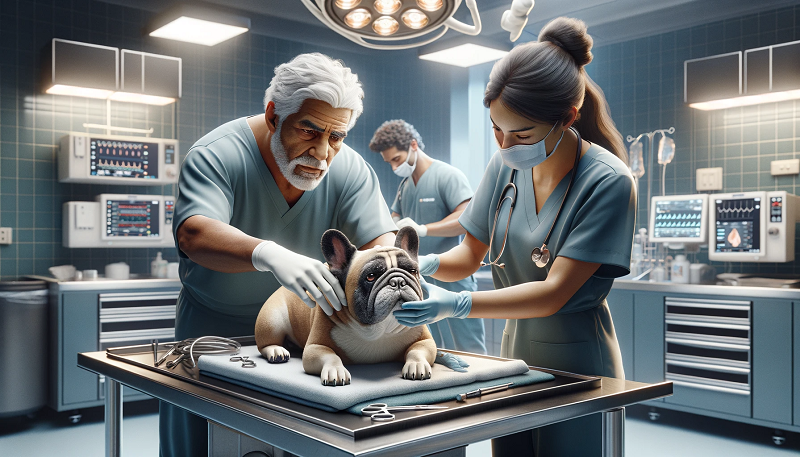Brachycephalic Obstructive Airway Syndrome (BOAS)
Brachycephalic breeds like French Bulldogs face breathing difficulties due to their unique craniofacial anatomy. Understanding and addressing these challenges are crucial for ensuring their comfort and health.

Written By
Dan Harrison
Editor

Co-Written By
Sarah Taylor
Writer

Reviewed By
Penny Worthington
Health

Research By
Sammi Slater
Researcher
Page Last Updated: 24th March 2024
On this page
Quickly find and read what interests you the most using the links below:
Introduction
Understanding the anatomy and physiology of French Bulldogs is important for recognising the challenges they face due to their distinct brachycephalic skull structure.
This unique anatomy shapes their appearance and makes them more prone to breathing difficulties, known as Brachycephalic Obstructive Airway Syndrome (BOAS).
Brachycephalic skull structure
“Brachycephalic” refers to the shortened head and flattened face in French Bulldogs.
This structure results from the disproportionate shortening of the nasal bones, which does not affect the soft tissue structures within the nasal passage and throat.
As a result, the soft tissues are effectively compressed into a much smaller area than would be found in a non-brachycephalic breed.
- Shortened nasal passage: The nasal passage in French Bulldogs is significantly shorter than in longer-nosed breeds. This shortened passage provides less area for air to be warmed and humidified before reaching the lungs, which can contribute to respiratory issues.
- Compact facial structure: The compactness of the facial structure further reduces the space available for airflow, making breathing less efficient and potentially leading to increased effort to breathe, particularly during exercise or stress.
Contribution to airway obstruction
Several key anatomical abnormalities arise from the brachycephalic structure, directly contributing to airway obstruction:
- Stenotic nares: This condition involves narrowing the nostrils, which can severely limit the air inhaled through the nose. Stenotic nares make breathing difficult for the dog, especially during physical exertion or in hot weather, as they cannot efficiently pant to cool down.
- Elongated soft palate: The soft palate is a section of the roof of the mouth that divides the nasal passages from the mouth. In French Bulldogs, the soft palate is often elongated to the point where it extends into the airway and partially blocks the entrance to the trachea (windpipe), especially during inhalation. This can lead to snoring sounds when the dog rests and significant breathing difficulty when exercising.
- Hypoplastic trachea: Hypoplastic trachea refers to a condition characterised by a narrower-than-normal windpipe or trachea. This congenital condition further restricts airflow to the lungs, compounding the difficulties caused by stenotic nares and an elongated soft palate. The reduced diameter of the trachea means that any additional obstruction in the upper airways can have a more pronounced effect on breathing efficiency.
Causes and risk factors
Understanding the causes and risk factors of Brachycephalic Obstructive Airway Syndrome (BOAS) in French Bulldogs involves looking into genetic predispositions and environmental factors contributing to the condition. This helps devise effective management and preventive strategies for affected dogs.
Genetic predispositions
French Bulldogs have been bred selectively for specific physical characteristics, including their broad heads, short muzzles, and flat faces like other brachycephalic breeds.
These traits are inherently linked to their genetic makeup and are passed down from generation to generation.
The aspects of their appearance that make them so appealing to many people are the same traits predisposing them to BOAS.
- Selective breeding and BOAS: Over generations, the selective breeding for more pronounced brachycephalic features has inadvertently intensified the health issues associated with these traits. The compacted skull structure directly contributes to the narrowed airways, leading to BOAS. As these physical traits are deeply embedded in the breed’s genetics, puppies inherit the risk of BOAS from their parents.
- Inherited anatomical abnormalities: The genetic predisposition includes inherited anatomical abnormalities such as stenotic nares (narrow nostrils), elongated soft palate, and a hypoplastic trachea (narrowed windpipe). While varying in severity among individual dogs, these abnormalities collectively obstruct normal breathing and directly contribute to BOAS.
Environmental factors
While genetic predispositions lay the groundwork for BOAS, environmental factors can significantly exacerbate the condition’s symptoms and impact a dog’s quality of life.
- Obesity: Obesity is a major environmental risk factor for BOAS. Extra weight adds pressure to brachycephalic dogs’ already compromised respiratory system, further restricting airflow and exacerbating breathing difficulties. The additional fat deposits in the neck and throat area can worsen the obstruction in the upper airways, making it even more challenging for affected dogs to breathe.
- High temperatures: French Bulldogs are particularly vulnerable to high temperatures due to their impaired ability to regulate body heat through panting. Panting is less efficient in dogs with BOAS because of their restricted airways, making it harder for them to cool down. Exposure to hot weather or environments can lead to overheating and heatstroke, emergencies requiring immediate veterinary attention.
- Exercise: While physical activity is essential for a dog’s overall health, strenuous exercise can be dangerous for French Bulldogs with BOAS. Overexertion can lead to respiratory distress as the demand for oxygen increases, but the dog’s ability to breathe efficiently is compromised.
Signs and symptoms of BOAS
Recognising the signs and symptoms of Brachycephalic Obstructive Airway Syndrome (BOAS) in French Bulldogs is paramount for timely intervention and preventing the progression to more severe complications.
Understanding these signs can guide owners seeking veterinary care when needed.
Here’s a look at the symptoms associated with BOAS:
Laboured breathing
In French Bulldogs, laboured breathing, or dyspnea, manifests as an apparent struggle to inhale or exhale.
Owners might notice their dog breathing heavily even after mild exertion, such as a short walk or during times of stress.
In hot weather, this condition is exacerbated due to the dog’s inefficient panting mechanism, which is their primary means of thermoregulation.
Signs to watch for include:
- Open-mouth breathing: A more pronounced effort to move air in and out, which is not typical in dogs unless they are panting due to heat.
- Abdominal heaving: Visible effort in the abdominal area as the dog tries to use accessory muscles to breathe.
Snoring and snorting
While snoring and snorting might seem normal for brachycephalic breeds, they are indicators of obstructed airways in French Bulldogs with BOAS.
These sounds result from turbulent airflow through the narrowed upper respiratory tract. Snoring typically occurs during sleep, but snorting can happen anytime, especially when the dog is excited or after drinking water.
These symptoms suggest that the dog is constantly battling restricted airflow, even in restful states.
Cyanosis
Cyanosis is a severe symptom indicating that the dog is not receiving enough oxygen. It manifests as a bluish tint to the gums, tongue, and lips, usually pink in healthy dogs.
This condition requires immediate veterinary attention, as it signifies severe oxygen deprivation.
Owners might notice cyanosis during or after physical activity, or in severe cases of BOAS, even at rest.
This symptom indicates that the dog’s breathing difficulties critically impact its oxygenation.
Collapse
In extreme cases, the effort required for a French Bulldog with BOAS to breathe can lead to collapse.
This can occur because of severe oxygen deprivation or overheating, as the dog cannot efficiently cool down through panting.
The collapse might be preceded by signs of distress, such as desperate attempts to find air, weakness, and disorientation.
It’s a dire emergency that underscores the severity of airway obstruction and the immediate need for veterinary care.
Importance of early recognition
Early recognition of these signs is crucial for the health and well-being of French Bulldogs with BOAS.
Timely veterinary intervention can prevent the syndrome’s progression and significantly improve the dog’s quality of life.
Owners should be particularly vigilant about monitoring their pets for these symptoms, especially as the dog ages or during warmer months when risks are heightened.
Diagnosing BOAS
Diagnosing Brachycephalic Obstructive Airway Syndrome (BOAS) in French Bulldogs requires a multifaceted approach to accurately assess the severity of the condition and plan an effective treatment strategy.
Veterinary evaluation
The initial step in diagnosing BOAS is a comprehensive clinical examination conducted by a veterinarian.
This examination focuses on observing the dog’s breathing patterns, evaluating for any audible signs of respiratory distress, and assessing physical features characteristic of BOAS.
Critical aspects of the evaluation include:
- Physical examination: Your vet will look for visible signs of BOAS, such as stenotic nares (narrowed nostrils), and assess the dog’s breathing effort at rest and after mild exertion. Observation of the dog’s general behaviour and condition, including signs of exercise intolerance or cyanosis (bluish discolouration of the mucous membranes), provides additional clues about the severity of the condition.
- Respiratory system assessment: Listening to the dog’s lung and airway sounds with a stethoscope helps the veterinarian detect any abnormalities suggestive of obstructed airways or secondary respiratory issues.
- Anatomical abnormalities: The vet will assess the standard anatomical features in BOAS-affected dogs, such as an elongated soft palate, which can be palpated indirectly or inferred from clinical signs.
Diagnostic procedures
More advanced diagnostic procedures are often necessary to confirm the diagnosis and assess the severity of BOAS.
These procedures provide detailed information about the dog’s airway structures and help identify specific anatomical abnormalities contributing to airway obstruction.
Endoscopy
This process involves utilising an endoscope, a flexible tube equipped with a camera and light inserted through the mouth into the airways.
Endoscopy enables direct visualisation of the internal structures of the throat and airways, facilitating the identification of abnormalities like elongated soft palate, everted laryngeal saccules, and laryngeal collapse.
Endoscopy is usually performed under general anaesthesia, which requires careful consideration given the respiratory risks associated with BOAS.
Imaging studies
Radiographs (X-rays) and computed tomography (CT) scans are valuable tools for evaluating the airway structures and chest.
They can reveal the extent of airway obstruction and provide images of the nasal passages, throat, and trachea.
These imaging techniques help identify conditions like hypoplastic trachea, where the windpipe is narrower than usual.
They can also detect signs of secondary complications, such as aspiration pneumonia, which can occur in dogs with BOAS due to inhalation of food or liquid into the lungs.
Assessment of severity
The combination of clinical examination and diagnostic testing enables the veterinarian to assess the severity of BOAS in the French Bulldog.
This assessment is crucial for determining the most appropriate treatment plan.
Factors considered in the severity assessment include the degree of airway obstruction, secondary respiratory issues, and your dog’s overall health and quality of life.
The diagnosis of BOAS requires a comprehensive approach that combines veterinary expertise with advanced diagnostic tools.
Understanding the specific anatomical abnormalities in each dog allows for tailored treatment plans to alleviate symptoms and improve the dog’s quality of life.
Early diagnosis and intervention are crucial to managing BOAS effectively and preventing the progression of this complex syndrome.
Treatment options
Treating Brachycephalic Obstructive Airway Syndrome (BOAS) in French Bulldogs requires a comprehensive approach that may include both surgical interventions and non-surgical strategies.
These treatments aim to alleviate the symptoms of BOAS, improve the dog’s breathing, and enhance their overall quality of life.
Here’s a look into the treatment options available for managing BOAS:
Surgical interventions
Surgery is often recommended for French Bulldogs with moderate to severe BOAS to correct anatomical abnormalities causing airway obstruction.
The specific procedures depend on the individual dog’s condition but typically include:
- Resection of the elongated soft palate: The elongated soft palate is trimmed to an average length, allowing for better lung airflow. This procedure reduces the blockage in the throat and can significantly improve breathing.
- Widening of stenotic nares: Surgical correction of narrowed nostrils involves removing some tissue to widen the nasal passages, facilitating easier air intake. This can be a relatively simple procedure that offers immediate improvement in nasal airflow.
- Removal of everted laryngeal saccules: Everted laryngeal saccules are pulled into the airway due to increased effort to breathe, further obstructing airflow. Their removal helps open up the airway, providing relief from respiratory distress.
These surgeries, often performed together, can dramatically improve the dog’s breathing ability.
However, they carry risks, particularly related to anaesthesia in brachycephalic breeds.
Postoperative care is crucial for monitoring the dog’s recovery and managing complications.
Medical management and lifestyle modifications
In addition to, or lieu of, surgical treatment, managing BOAS includes several non-surgical strategies aimed at reducing respiratory stress and improving the dog’s comfort:
- Weight management: Excess weight puts additional pressure on the respiratory system, exacerbating breathing difficulties.
Keeping a healthy weight with a well-rounded diet and consistent, moderate exercise can reduce respiratory strain and enhance overall well-being. - Cool environment: Dogs with BOAS are at severe risk of overheating due to their compromised ability to pant effectively. Keeping them in a cool, air-conditioned environment, especially during hot weather, is critical to prevent heatstroke and respiratory distress.
- Controlled exercise: While exercise is essential for maintaining a healthy weight and overall well-being, it must be carefully managed to avoid overexertion. Short, leisurely walks in cool weather are preferable, and strenuous activities should be avoided. Using a harness rather than a collar can ease pressure on the throat and airway.
Prognosis and long-term management
The prognosis and long-term management of Brachycephalic Obstructive Airway Syndrome (BOAS) in French Bulldogs are influenced by many factors, including the severity of the condition, the success of interventions (both surgical and non-surgical), and the commitment to ongoing care and lifestyle modifications.
Here’s a look into factors affecting the prognosis and how long-term management can optimise the quality of life for French Bulldogs with BOAS.
Prognosis
The prognosis for French Bulldogs diagnosed with BOAS can range from good to guarded, largely dependent on:
- Severity of condition: When properly treated and managed, dogs with mild to moderate BOAS can enjoy a relatively normal life with few restrictions. However, dogs with severe BOAS, especially those experiencing significant respiratory distress or secondary complications such as heart strain, have a more guarded prognosis.
- Timeliness and effectiveness of treatment: Early intervention often results in a better prognosis. Surgical corrections can significantly improve breathing and reduce the risk of severe complications if performed before the condition leads to irreversible damage or secondary health issues.
- Response to treatment: Individual response to treatment also plays a crucial role. Dogs that respond well to surgical intervention and whose owners are committed to recommended lifestyle changes generally have a positive outlook.
- Secondary complications: The development of secondary complications such as chronic respiratory infections, heart problems, or heatstroke can impact the prognosis. Ongoing management aims to minimise these risks.
Long-term management
Managing a French Bulldog with BOAS is a lifelong commitment that involves regular veterinary care, lifestyle adjustments, and vigilance from the owner. Critical components of long-term management include:
- Regular veterinary check-ups: Routine examinations monitor the dog’s respiratory function and overall health. These visits may also assess the effectiveness of any surgical interventions and adjust the treatment plan as necessary.
- Weight control: Maintaining an ideal body weight is critical. Obesity exacerbates breathing difficulties and can negate the benefits of surgical treatment. A balanced diet and appropriate exercise are central to weight management.
- Avoiding environmental stressors: Protecting dogs from extreme temperatures, high humidity, and environmental pollutants can prevent respiratory distress. It is particularly important to keep dogs in a climate-controlled environment during hot weather.
- Exercise management: Exercise is vital for overall health but must be carefully moderated to prevent overexertion. Short, controlled walks in cooler parts of the day and avoiding strenuous activities are recommended.
- Breathing and sleeping aids: In some cases, owners may need specialised bedding to help their dog maintain an open airway position while sleeping. Humidifiers can also help by keeping the air moist, reducing the risk of respiratory irritation.
- Monitoring for secondary health issues: Owners should be vigilant for signs of secondary health problems such as respiratory infections or signs of heart strain and seek prompt veterinary care.
Final thoughts
BOAS in French Bulldogs is a significant concern that requires a multifaceted approach, including preventive measures, early diagnosis, and comprehensive treatment plans.
By understanding the intricacies of this syndrome, owners can take proactive steps to ensure their French Bulldogs live fuller, less restricted lives.
Albino (Pink)
Black and Tan
Blue
Brindle
Chocolate
DNA Charts
Fawn
Fluffy
Hairless
Isabella
Lilac
Merle
Pied
Platinum
Sable
Teacup
Dry Dog Food
Fresh Dog Food
Gastrointestinal Dog Food
Grain-Free Dog Food
Hypoallergenic Dog Food
Low-Fat Dog Food
Organic Dog Food
Raw Dog Food
Wet Dog Food
Recipes
Dog Treats
Vitamins and Supplements
Grooming
Health & Wellbeing

Terms of Use
Privacy Policy
GDPR Policy
Transparency Policy

